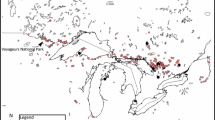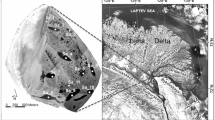Abstract
The distribution of microcrustacea in the water column, sediments and on different macrophyte species was examined in the littoral zone of Jack Lake, Nova Scotia, Canada. Large numbers of microcrustacea occurred in association with macrophytes, suggesting that this habitat should receive greater attention in future studies of microcrustacean numbers, biomass, and production. The relative abundance of different microcrustacea varied considerably among sediments, macrophytes and water column samples. Although microcrustacean species composition differed among macrophyte groups, consistent differences in absolute numbers per gram could not be demonstrated. Epiphytic microcrustacean community structure also varied among depth strata in Jack Lake. Few epiphytic and benthic microcrustacea migrated into the water column on a diurnal basis.
Similar content being viewed by others
References
Cooley, W. W. & P. R. Lohnes, 1971. Multivariate data analysis. J. Wiley & Sons, New York, 364 pp.
Crisman, T. L. & D. R. Whitehead, 1978. Paleolimnological studies on small New England (U.S.A.) ponds. Part II. Cladoceran community responses to trophic oscillations. Pol. Arch. Hydrobiol. 25: 75–86.
Cyr, H. & J. A. Downing, 1988a. Empirical relationships of phytomacrofaunal abundance to plant biomass and macrophyte bed characteristics. Can. J. Fish. aquat. Sci. 45: 976–984.
Cyr, H. & J. A. Downing, 1988b. The abundance of phytophilous invertebrates on different species of submerged macrophytes. Freshwat. Biol. 20: 365–374.
Daggett, R. F. & C. C. Davis, 1974. A seasonal quantitative study of the littoral Cladocera and Copepoda in a bog pond and acid marsh in Newfoundland. Int. Revue ges. Hydrobiol. 59: 667–683.
Davies, J., 1985. Evidence for a diurnal horizontal migration in Daphnia hyalina lacustris Sars. Hydrobiologia 120: 103–105.
DiFonzo, C. D. & J. M. Campbell, 1988. Spatial partitioning of microhabitats in littoral cladoceran communities. J. freshwat. Ecol. 4: 303–313.
Downing, J. A., 1986. A regression technique for the estimation of epiphytic invertebrate populations. Freshwat. Biol. 16: 161–173.
Evans, M. S. & J. A. Stewart, 1977. Epibenthic and benthic microcrustaceans (copepods, cladocerans, ostracods) from a nearshore area in southeastern Lake Michigan. Limnol. Oceanogr. 22: 1059–1066.
Flossner, D., 1985. The meiozoobenthos. In Lake Stechlin. A temperate oligotrophic lake. Dr W. Junk, Boston: 219–229.
Fryer, G., 1957. The food of some freshwater cyclopoid copepods and its ecological significance. J. anim. Ecol. 26: 263–286.
Fryer, G., 1968. Evolution and adaptive radiation in the Chydoridae (Crustacea: Cladocera): a study in comparative functional morphology and ecology. Phil. Trans. r. Soc., Lond. B 254: 221–385.
Fryer, G., 1974. Evolution and adaptive radiation in the Macrothricidae (Crustacea: Cladocera): a study in comparative functional morphology and ecology. Phil. Trans. r. Soc., Lond. B 260: 137–274.
Gehrs, C. W., 1974. Horizontal distribution and abundance of Diaptomus clavipes Schacht in relation to Potamogeton foliosus in a pond and under experimental conditions. Limnol. Oceanogr. 19: 100–104.
Hare, L. & J. C. H. Carter, 1976. Diacyclops nanus (Cyclopoida: Copepoda), a new record from the St. Lawrence Great Lakes. J. Great Lakes Res. 2: 294–295.
Hargeby, A., 1990. Macrophyte associated invertebrates and the effect of habitat permanence. Oikos 57: 338–346.
Jackson, D. A., H. H. Harvey & K. M. Somers, 1990. Ratios in aquatic sciences: statistical shortcomings with mean depth and the morphoedaphic index. Can. J. Fish. aquat. Sci. 47: 1788–1795.
Lalonde, S. & J. A. Downing, 1991. Epiphyton biomass is related to lake trophic status, depth, and macrophyte architecture. Can. J. Fish. aquat. Sci. 48: 2285–2291.
Meyers, D. G., 1980. Diurnal vertical migration in aquatic microcrustacea: light and oxygen responses of littoral zooplankton. In W. C. Kerfoot(ed.), Evolution and Ecology of Zooplankton Communities. The University press of New England, Hanover (N.H.): 80–90.
Meyers, D. G., 1984. Habitat shifting, feeding mode versatility, and alternate resource exploitation by herbivorous cladoceran zooplankton in a montane lake. In D. G. Meyers & J. R. Strickler (eds), Trophic interactions within aquatic ecosystems. AAAS Selected Symposium 85: 309–345.
Neter. J., W. Wasserman & M. H. Kutner, 1983. Applied linear regression models. Richard D. Irwin, Homewood, 547 pp.
Patalas, K., 1971. Crustacean plankton communities in fortyfive lakes in the Experimental Lakes Area, northwestern Ontario. J. Fish. Res. Bd Can. 28: 231–244.
Paterson, M. J., 1991. Invertebrate predation and the seasonal dynamics of microcrustacea in the littoral zone of Jack Lake, Nova Scotia. Ph. D. thesis, Dalhousie University, Halifax, 235 pp.
Paterson, M. J., 1993. Invertebrate predation and the seasonal dynamics of microcrustacea in the littoral zone of a fishless lake. Arch. Hydrobiol. Suppl. (in press)
Pennak, R. W., 1962. Quantitative zooplankton sampling in littoral vegetation areas. Limnol. Oceanogr. 7: 487–489.
Pielou, E. C., 1984. The interpretation of ecological data. John Wiley & Sons, New York, 263 pp.
Pip, E. & J. M. Stewart, 1976. The dynamics of two aquatic plant-snail associations. Can. J. Zool. 54: 1192–1205.
Quade, H. W., 1969. Cladoceran faunas associated withaquatic macrophytes in some lakes in northwestern Minnesota. Ecology 50: 170–179.
Sokal, R. R. & F. J. Rohlf, 1981. Biometry, 2nd edn. W. H. Freeman and Co., San Francisco, 859 pp.
Strayer, D., 1985. The benthic micrometazoans of Mirror Lake, New Hampshire. Arch. Hydrobiol. Suppl. 72: 287–426.
Tinson, S. & J. Laybourn-Parry, 1985. The behavioral responses and tolerance of freshwater benthic cyclopoid copepods to hypoxia and anoxia. Hydrobiologia 127: 257–263.
Vuille, T., 1991. Abundance, standing crop and production of microcrustacean populations (Cladocera, copepoda) in the littoral zone of Lake Biel, Switzerland. Arch. Hydrobiol. 123: 165–185.
Whiteside, M. C., 1974. Chydorid (Cladocera) ecology: seasonal patterns and abundance of populations in Elk Lake, Minnesota. Ecology 55: 538–550.
Whiteside, M. C. & J. B. Williams, 1975. A new sampling technique for aquatic ecologists. Verh. int. Ver. Limnol. 19: 1534–1539.
Whiteside, M. C., J. B. Williams & C. P. White, 1978. Seasonal abundance and pattern of chydorid Cladocera in mud and vegetative habitats. Ecology 59: 1177–1188.
Wilkinson, L., 1990. SYSTAT: the system for statistics. SYSTAT Inc., Evanston, 822 pp.
Williams, J. B., 1982. Temporal and spatial patterns of abundance of the Chydoridae (Cladocera) in Lake Itasca, Minnesota. Ecology 63: 345–353.
Author information
Authors and Affiliations
Rights and permissions
About this article
Cite this article
Paterson, M. The distribution of microcrustacea in the littoral zone of a freshwater lake. Hydrobiologia 263, 173–183 (1993). https://doi.org/10.1007/BF00006268
Received:
Revised:
Accepted:
Issue Date:
DOI: https://doi.org/10.1007/BF00006268




